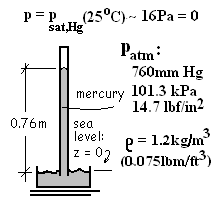| THERMO Spoken Here! ~ J. Pohl © | TOC NEXT ~ 69 |
2.02 Standard Atmosphere
A mercury barometer can be used to quantify the local, i.e., ambient pressure of atmospheric air. Prior to the work of Torricelli it was only known "how fluid pressure differed at different elevations above Earth." Pressure within a fluid was known to be greater at locations of less elevation (closer to earth) and conversely, less at greater elevations. The hydrostatic equation, Eqn-1, expresses this fact mathematically, as a first-order differential equation.

| (1) |
To solve the differential equation, (to obtain a function, p(z), expressing the pressure in the fluid) one must know the pressure and elevation at some point. In 1630, Evangelista Torricelli invented the barometer and in doing so, he believed he had determined a fluid location for which he knew the pressure. The location was "in the "void" at the top of the barometer and Torricelli assumed the pressure in the void to be zero.
 Earth-surface atmospheric pressure varies with time (at a
Earth-surface atmospheric pressure varies with time (at a
location) and with location (at the same time). A spatial and
temporal average value is useful for calculations.
We now know that the pressure "in the void" of a mercury barometer is not zero. The pressure in the void equals the vapor pressure of mercury at the ambient temperature; psat,Hg(T=25°C) = ~16Pa.
very low pressure indeed; but not zero. Although it is not
Torricelli rappears at the top of the that "local pressures in a fluid decrease with increase of
elevation above Earth (and the converse, atmospheric pressures increases s greater that it becwas less at the higher thhe elevation above Earth (and decreased as one moved upward in a fluid
and conversely, increased as one m The barometer, according to Torricelli's discovery, the pressure in the void above mercury is zero (the first quantified pressure).
Calculate patm:
Use information of the figure to calculate the pressure of "standard atmosphere." The first step is to "separate variables" of Eqn-1 to obtain Eqn-3. Next apply "integration operators" and recognize that the density of mercury and the local acceleration are constant: bring them ahead of the right-side integration - to obtain Eqn-3.

| (2) |

| (3) |
The steps resuting in Eqn-2 and Eqn-3 are perfunctory. Next limits of the integration must be applied to Eqn-3. The integral is visualized to follow a path "from" an initial location (1) having a known elevation and known pressure, through the fluid in question to a final location (2) of known elevation but unknown pressure - our case. (Or the case might be "to" a final location at which the pressure is known but unknown elevation.)
We apply the hydrostatic principle starting at the surface of the mercury "in the void" (1). At that location the pressure is, p1 = 16Pa and the elevation is, Z1 = 0.760m. Integration will be along a path downward from (1), through liquid mercury to its final surface (2) where the unknown pressure is patmosphere and the elevation is Z = 0.0m (sea level).
| pressure | elevation | |
| Upper Limit (2) | patmosphere | 0.000m |
| Lower Limit (1) | 16 Pa | 0.760m |
Next place these limits properly and integrate Eqn-4. The density of mercury and acceleration of gravity are entered. For this example, these numbers need to be precise.

| (4) |
Next to the assumed "zero pressure" of the mercury vapor in the "void" of a barometer, the most commonly assumed pressure is "Standard Atmosphere." Measurements of atmospheric pressure have been recorded at sea level all over Earth for centuries and have been found (except during storm conditions) to vary slightly from the average value, 101.3 kPa (or 14.7 psi).
| Standard Atmosphere | ||
| T = 25°C | p = 101.3 kPa | ρ = 1.2 kg/m3 |
| T = 80°F | p = 14.7 lbf/ft2 | ρ = 0.075 lbm/ft3 |
In the absence of a specified pressure, engineers assume the values of the table to be standard.
2.02 Standard Atmosphere
A properly installed barometer can be used with the hydrostatic equation to quantify the pressure of the atmosphere. With the barometer, according to Torricelli's discovery, the pressure in the void above mercury is zero (the first quantified pressure).
We let the hydrostatic principle start "in the void" and be applied along a path downward through liquid mercury to the atmosphere (at zero elevation and sea level). Thus the magnitude of term (1) (previous page) is zero and the result of the calculation will be the pressure of the atmosphere.
Premise presently unwritted!